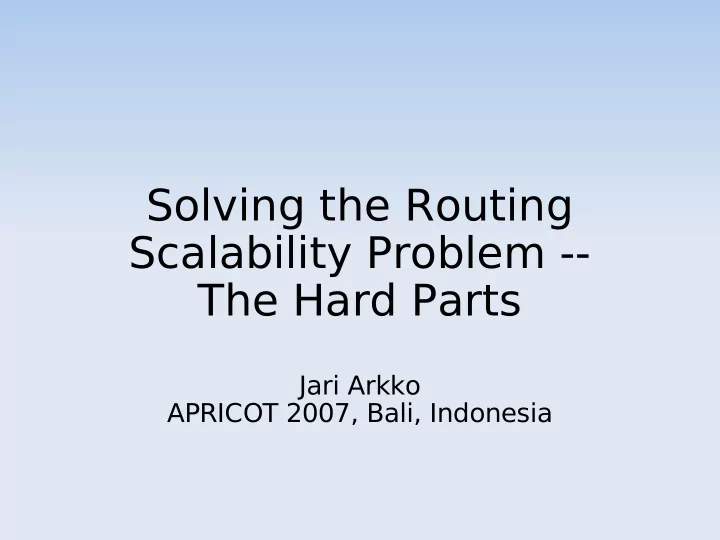

Solving the Routing Scalability Problem -- The Hard Parts Jari Arkko APRICOT 2007, Bali, Indonesia
Outline Where are we on this? Some hard bits Proposed plan of action
Where Are We on This? There is a lot of interest People willing to design solutions Discussion forums & meetings exist Pretty good understanding and agreement about why this problem occurs
Where Are We on This? II There are different interpretations of how serious or not the problem is − Not everyone believes we have an issue that cannot be addressed by throwing more hardware at it without significant cost impact Different opinions with regards to what is most important, e.g. FIB size vs. dynamics People working for many different directions and on different time scales Have not hit all the hard questions yet
Hard Parts I – The Meta Issue Agreeing on how serious the problem is Throw hardware or protocols at it? But the engineering community should not work only on Internet threatening issues! Can we improve the current design? − E.g., more users or more provider independence or more multihoming for the users with the same effort Sets limits on what kind of solutions can be considered
Hard Parts II – Router Scalability Not just about the forwarding decision − Also need BGP computation and communication, move data from the RIB to FIB, meaningful management tools for large tables, and so on Conversely, router hardware has to do many other things as well − Filtering, prioritization, source address validation, tunneling, ... (list keeps growing) What you see is a sum of different factors And commercial issues affect this, too...
Hard Parts II – Deployment Deployment and use is what counts The hard part is an actual table impact! What is the motivation for deployment? − Host/router/peer/DNS/... If the same organization spends the cost and gets the benefits, we have a good model If not, it is questionable what motivates others to deploy something new
Hard Parts II – Deployment Cont'd Relatively easy to upgrade some interested set of end hosts Very hard or impossible to expect upgrades from everyone Its a complete non-starter to require application modifications
Hard Parts III – Applications Referrals – how do they work? Host stores peer's address in file and attempts to contact it later when the host stack and router have lost the context. Can you find the peer's locator? Or, host sends what it thinks is an address to a peer in SIP/SDP. Does the peer know where to send the packet? Particularly hard problem when communicating with legacy nodes AND simultaneously reducing DFZ table size
Hard Parts IV – Security How do you secure the mapping? Are dynamic changes allowed? Can I claim that your identity is now in my computer? The solutions that we have seen have wildly different approaches to security
Hard Parts V – Scope How ambitious is this effort? Routing scalability in the fixed network? ... with multihoming? ... with mobility? ... with secure identifiers (e.g. HITs) ... with e2e security (e.g. HIP ESP)? ... with denial-of-service defences (Hi3)? ... clean slate?
Hard Parts VI – Limits of an IP Solution Ease of renumbering is not just a host / router problem – DNS, firewalls, application configs, etc. are involved The pressure to keep the same locators may not go away completely Solutions that employ identifier space that looks syntactically like an address may get additional pressure to route on identifiers as well
What Can the IETF Do? Routing table size growth causes pain There is reason to believe we do not have a short term technology problem − But hard work and many commercial issues are ahead. Much of this is outside IETF scope, however. IETF can help in short term protocol work Such as tuning BGP better for today's challenges − IETF can also help by looking at architectural changes Takes time to develop (and more to deploy) −
Overall Plan We need to in parallel Continue tracking the problem Keep educating the operator community Encourage implementation improvements Start up short-term BGP improvements Encourage Id-Loc split experimentation Eventually produce an IETF Id-Loc split
Identifier-Locator Split Its easy to charter additional work here However, lets not forget that deployment is the true change, not a new invention Should focus on things that we currently cannot do (such as control from the network) Look at both IPv4 and IPv6 -- be backwards compatible Not a replay of the 1990's – we know more now Will take time! IRTF work on clean slate designs, experimental RFCs on candidate ideas, IETF standard work
Recommend
More recommend